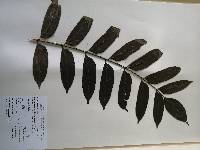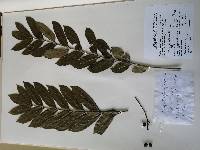
Neotropical Flora
|
Family: Anacardiaceae
|
Mosquito wood, Jobillo, Carbonero Tree to 30 m high; trunk to 60 cm dbh, weakly buttressed; outer bark weakly fissured; inner bark thin, reddish, forming white sap droplets when cut; wood white. Leaves imparipinnate, alternate, 10-30 cm long, clustered toward apex of branches; leaflets 5-17, usually opposite, short-petiolulate; blades mostly oblong, variable and emarginate to acuminate at apex, cuneate and unequal at base, 2.5-10 cm long, 1.5-3.5 cm wide, usually pubescent on both surfaces especially on midrib. Panicles 7-27 cm long, hirtellous; flowers minute, 5-parted, sessile, bisexual, each subtended by 3, persistent, deltoid bracts ca 1 mm long; sepals ovate, ca 1 mm long, ciliate; petals ca 1 mm. long; stamens 5, ca 1 mm long, inserted at margin of disk; disk cupular, 5-lobed, each lobe secondarily lobed; style 1, persistent, tripartite at apex. Drupes 6-9 mm long, red, shiny, glabrous, laterally oblique and somewhat flattened; mesocarp thin, bitter but edible; seed 1, its funiculus subbasal. Croat 12565. Uncommon, in the forest. Seasonal behavior uncertain. Flowers from June to August, but probably later in the rainy season as well. The fruits mature from July to January, but mostly from August to December. The January fruiting record is from higher elevations in Panama in tropical wet forest. Mexico to Panama; West Indies. In Panama, known from tropical moist forest in the Canal Zone and Darien, from premontane wet forest in the Canal Zone, Colon, and Panama, and from tropical wet forest in Coclé. See Fig. 328. |
|
|
|
Powered by Symbiota.























